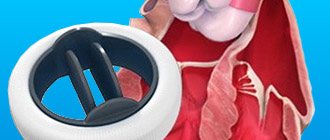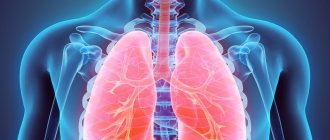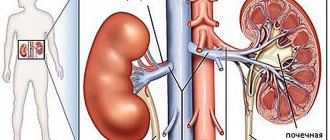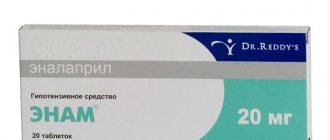Increased intracranial pressure in a child (arterial hypertension, intracranial hypertension) is a common disorder that can be a sign of various diseases. Intracranial pressure increases with brain tumors, hydrocephalus, neuroinfections (meningitis, encephalitis), intracerebral effusions, traumatic brain injuries, some hereditary pathologies and other diseases.
The development of arterial hypertension in a child is especially dangerous. Unstable pressure readings can cause serious abnormalities in brain development: mental retardation, blindness, paralysis and other pathological conditions.
Increased intracranial pressure is not always a sign of disorders. It can increase with everyday activities: defecation, coughing, stressful situations, suckling at the mother's breast, lifting heavy objects. It is not dangerous for the child. If intracranial pressure increases regularly and is permanent, parents and their child should seek medical help.
Clinical picture (symptoms)
With arterial hypertension, the manifestations are different and depend on the severity. With moderate high blood pressure, there may be no symptoms, but rarely the child experiences headaches, fatigue, and excessive irritability. A significant increase in blood pressure is accompanied by:
- anxiety;
- unmotivated crying;
- apnea attacks;
- shortness of breath.
Pulmonary hypertension manifests itself:
- heavy breathing of the child;
- retracting the pliable parts of the chest while inhaling;
- reduced saturation (saturation of hemoglobin with oxygen);
- cyanosis of the skin and mucous membranes.
With increased pressure in the pulmonary arteries, the child’s response to oxygen therapy is practically absent, which is why the procedure is ineffective.
Among the clinical manifestations of intracranial high pressure :
- decreased sucking activity;
- tense, swollen fontanelles that lack pulsation;
- dilated superficial veins of the head area;
- unmotivated crying, screaming;
- convulsions;
- divergent cranial sutures;
- damage to the cranial nerves, which is accompanied by impaired motor functions of the eyeball, sense of smell, work of the cervical, facial and trapezius muscles, heart, gastrointestinal tract and many other systems.
Also, the newborn develops Graefe syndrome, in which part of the sclera can be seen at the top of the eyeball. The phenomenon is observed only when the child’s eyes are downcast.
Symptoms
The pathological condition can manifest itself in different ways. The main signs of increased blood pressure are usually accompanied by characteristic symptoms of the primary disease. In addition, a lot depends on the age of the child. Symptoms and treatment of infants and schoolchildren have their own characteristics.
It makes sense to distinguish between two age categories that have differences in the manifestation of increased intracranial pressure. The first group is children who have not yet turned one year old. The second is children older than this age. Why is one year of age a cutoff point? By this age (give or take a few months), the last “fontanelle” on the baby’s head usually heals. “Fontanelle” is a section of the skull in which there are openings between the bones.
How to determine increased intracranial pressure in children under one year of age? There are many symptoms, but each of them is not an unambiguous indication of a dangerous diagnosis; they can only be used to suspect the presence of a pathology in a child.
- The child cries and screams for a long time for no apparent reason, behaves restlessly, and is nervous.
A characteristic sign of pathology is frequent crying at night. It is at this time, when the baby must be in a lying position for a long time, the outflow of blood through the veins of the brain is inhibited, the blood stagnates, overflowing the vessels, and disrupts the outflow of cerebrospinal fluid. The pressure in the skull increases.
- The child has poor, short-term sleep: he has difficulty falling asleep, constantly wakes up, and cries.
The explanation is the same: when the baby lies, the movement of blood from the head slows down.
- Under the thin skin on the baby's head, you can see a pronounced network of blood vessels.
This happens because when the pressure on the brain increases, the venous vessels collect a large amount of blood, which cannot drain away. As a result, the veins located under the skin become clearly defined.
- The child began to eat poorly.
The process of extracting milk from the mother's breast is a very labor-intensive task for the infant. When it “works,” it naturally begins to increase. If the baby is healthy, this will not cause him any discomfort. But in the case of an existing fact of increased pressure inside the skull above normal, the additional load makes itself felt. The baby experiences pain and discomfort, so he abandons the breast. As a result, you can notice a lag in weight in such a child.
- The baby constantly burps, and profusely. There are frequent attacks of vomiting. Such symptoms indicate the possibility of developing intracranial hypertension.
But in this case, we cannot exclude the presence of other causes, which are also characterized by such a symptom: overeating, air entering the esophagus.
- Upon examination, the doctor may find that the “fontanelles” have become convex and swollen. There is also often a disproportionate increase in head volume. The forehead especially grows. The sutures of the cranial bones begin to separate.
The normal volume of the head should be less than the volume of the baby's chest, starting from 6 months. If this does not happen, and the head is still large, this should serve as an alarming signal. Violation of proportions can be noticed in dynamics with regular head measurements.
- The baby’s development is inhibited, retardation is observed both in physical and mental parameters.
- There is a disorder in the functions of the nerves responsible for the movement of the eyeballs. This phenomenon is commonly called Graefe syndrome.
This sign can be noticed by the spontaneous lowering of the eyeballs; a white stripe (sclera) is clearly visible in the gap between the upper eyelid and the iris of the eye.
Due to the external similarity of the phenomena, this symptom is also called the “setting sun symptom.”
It would also be advisable to consider the symptoms of the pathological condition in older children (after 6 years):
- frequent attacks of nausea, vomiting may occur;
- pain in the eyeball area;
- difficulty falling asleep;
- dizzy;
- seeing double;
- chronic fatigue, lethargy, apathy;
- emotions are overflowing: aggression, tearfulness, whims for no reason;
- convulsive syndrome;
- headache in the evenings and at night;
- attention is scattered, the child has become forgetful.
Reasons for the development of the pathological condition
Among the main reasons for the development of the pathological process, doctors name:
- Heredity.
- Somatic pathologies.
- Exchange disorders.
Manifestation of headache
| Organs and systems | Nature of pathological processes |
| Kidneys | |
| CNS | |
| Heart and circulatory system | |
| Endocrine system | |
| Other anomalies |
Factors for the development of ICH
The main provocateur of intracranial pathology is the improper movement of fluid that is produced by the ventricles of the brain.
An episodic jump in ICP can also occur in a completely healthy baby for physiological reasons, for example, during the period of crying or breastfeeding, which is explained by physical and mental stress at this moment.
If it is impossible to determine the provoking factor of the painful condition, doctors diagnose the baby with a congenital pathology - intracranial hypertension of the idiopathic type.
Causes of pulmonary hypertension
Pulmonary hypertension in infants of the persistent type is diagnosed in babies born on time or post-term.
- Indirect signs of intracranial hypertension
Main reasons for development:
- Hypoxia or suffocation during the perinatal period of the fetus.
- Meconium staining of amniotic fluid.
- Penetration of original feces into the trachea.
- Respiratory distress syndrome.
- Closure of the foramen rotundum or arterial canal.
- Underdevelopment of the entire lung structure.
- Diaphragmatic hernia of intrauterine nature.
- Pneumonia of newborns (neonatal sepsis).
Memo to parents
Head and chest circumference standards
| Age | Head circumference | Chest circumference |
| 1 month | 38.0 cm | 37.5 cm |
| 2 months | 39.0 cm | 38.5 cm |
| 3 months | 40.0 cm | 39.5 cm |
| 4 months | 41.5 cm | 41.0 cm |
| 5 months | 42.5 cm | 42.0 cm |
| 6 months | 43.5 cm | 43.5 cm |
| 7 months | 44.0 cm | 44.5 cm |
| 8 months | 44.5 cm | 45.0 cm |
| 9 months | 45.0 cm | 45.5 cm |
| 10 months | 45.5 cm | 46.0 cm |
| 11 months | 46.0–46.5 cm | 46.5 cm |
| 12 months | 47–49.0 cm | 48–50 cm |
Signs of intracranial pressure in a child
In children, the following signs of persistent increased intracranial pressure are identified:
- headache;
- nausea;
- pain in the chest cavity;
- irritability;
- vomit;
- loss of appetite;
- moderate weight loss;
- fatigue.
Intracranial hypertension in infants
With the development of benign hypertension, the occurrence of dangerous complications, such as hydrocephalus or deformation of the bones or sutures of the skull, is not observed. Severe ICH is usually a consequence of neurological pathologies, brain tumors or injuries, which are accompanied by hemorrhage. The main symptoms of ICP in one-year-old children:
- long healing of fontanelles;
- restless sleep;
- increase in head size;
- delayed neuropsychic and physical development.
What can cause brain pathologies?
The main cause of ICP in infants is hydrocephalus, which occurs due to increased production of cerebrospinal fluid.
As a result, excess fluid accumulates in various parts of the brain, disrupting the normal patency and absorption of cerebrospinal fluid. Typically, hydrocephalus in the fetus begins to develop in the last months of a woman’s pregnancy. Symptoms of this congenital disease can be detected immediately after birth. If treatment is started in a timely manner, there is every chance that the child’s cranial pressure will soon return to normal.
There are cases when cranial pressure in an infant increases gradually, the reason for this may be:
- a genetic or chromosomal disorder that causes congenital neurological defects;
- very early birth, when the child’s cerebral cortex has not yet fully formed;
- difficult pregnancy with pathologies;
- intrauterine infectious disease transmitted to the child from the mother;
- birth injuries to the head or concussion.
Among the diseases accompanied by the development of ICP, the most common are:
- encephalopathy and hydrocephalus;
- neuroinfectious diseases (meningitis, encephalitis, etc.);
- severe disturbance of metabolic processes in the body, leading to diabetes mellitus and hypothyroidism;
- brain tumor.
ICH treatment tactics
When ICH syndrome is detected, therapy is carried out under medical supervision. The need for inpatient treatment is due to the fact that intracranial hypertension is not an autonomous disease, but acts as a sign of another pathological process (hydrocephalus or encephalopathy). Therefore, doctors need to find the root cause of this abnormality.
Therapy of intracranial hypertension in one-year-old children is carried out using several methods, based on the severity of the pathology.
For mild to moderate severity of the disease, non-drug and drug therapy is practiced:
- With a non-drug approach, it is recommended: diet, massage, physiotherapy, therapeutic exercises.
- With regular surges in intracranial pressure, medications are prescribed whose action is aimed at stopping the etiological factor. Additionally, one or more types of diuretics are prescribed.
At the same time, a number of therapeutic measures are carried out to significantly improve the baby’s well-being and prevent the development of complications.
Drastic treatment methods are also practiced in advanced stages of intracranial hypotension or the presence of a malignant focus, when the use of conservative measures is no longer advisable.
Take note
A sign of increased intracranial pressure is not:
- increased muscle tone;
- pulsation of the parietal fontanel;
- the child supports or walks on the forefoot (toes, toes);
- tongue sticking out;
- restless sleep, frequent waking up and screaming in sleep;
- trembling (tremor) of the chin.
Article on the topic
Pediatrician secrets. What to do if a child complains of pain The following symptoms may indicate increased intracranial pressure:
- an increase or decrease in the size of the head by more than 3 cm from the norm (see table), however, it is important to look at the ratio of the head circumference to the chest;
- large size and tension of the parietal fontanel (when you touch it, it is tight);
- divergence of cranial sutures;
- significant changes in the fundus.
Types of neonatal hypertension and causes of their occurrence
In pediatrics, there are 3 types of hypertension:
- Arterial.
- Pulmonary.
- Intracranial.
Depending on the type of pathological phenomenon, the clinical picture, complications, treatment methods and causes will vary.
- All about intracranial hypertension: causes, symptoms, diagnosis and treatment
Arterial hypertension
This is a secondary disease, which most often manifests itself against the background of other pathologies of the child. For a baby born at 38-42 weeks of gestation (full-term baby), the diagnosis of arterial hypertension is made when the systolic pressure level is more than 90 mmHg. Art., diastolic - more than 60. For premature babies, the level of indicators for diagnosis is reduced to 80 and 50 mm Hg. Art. respectively.
Possible causes of arterial hypertension in newborns:
- coarctation of the aorta;
- blockage or blood clots in the renal arteries;
- pyelonephritis;
- renal failure;
- kidney tumor or hyperplasia of renal tissue.
Kidney pathologies occupy a significant place in the development of hypertension and account for about 70% of all cases of the disease in children. Also, the pathological condition in question may occur against the background of an unsuccessful blood transfusion to the baby.
You can learn from this video what a disease such as arterial hypertension is, how it is characterized and why it can occur in children.
Pulmonary hypertension
This is a syndrome in which an infant experiences increased pressure in the pulmonary arteries. The syndrome manifests itself in 2 forms: primary and secondary.
Primary hypertension occurs in 0.3% of cases in both full-term and post-term infants. Causes of primary hypertension:
- pathologies that lead to hypoxia and asphyxia;
- diaphragmatic hernia;
- neonatal sepsis.
Secondary syndrome is the result of congenital diseases affecting the lung parenchyma. Possible causes of the disease:
- meconium aspiration syndrome;
- distress syndrome;
- pneumonia in a newborn.
Premature babies are less susceptible to this disease, which is due to the anatomical features of the development of smooth muscle tissue that surrounds the arterioles and appears by the 30th week of the gestational period.
- Intracranial pressure in infants: symptoms, dangers, how to treat
This video talks about the features of pulmonary hypertension in children: forms, symptoms, diagnosis, and other nuances.
Intracranial hypertension
Hypertension is characterized by increased intracranial pressure. This condition is a manifestation of another pathology that cannot occur independently.
Diseases that can cause the development of hypertension:
- intrauterine hypoxia;
- birth of a child at 22-30 weeks of pregnancy;
- tumor, the presence of other foreign tissues compressing the tissue of the cerebral hemispheres;
- injuries to the head and neck vessels that occurred during passage through the birth canal.
An increase in intracranial pressure occurs due to an increase in fluids, such as tissue, cerebrospinal fluid, and blood, which compress the brain tissue.
What does ICP mean?
To understand how dangerous this is, you need to first study the anatomy of the baby’s head and figure out what processes occur in it.
The brain is located inside several membranes - arachnoid, soft and hard, surrounded on top by the bones of the skull. Inside the organ itself there are ventricles - cavities. There is cerebrospinal fluid present inside the ventricles and between the membranes.
Liquor is a clear, colorless liquid, very similar in appearance to water, containing a small amount of cells, protein and salts. In an infant, the amount of cerebrospinal fluid is about 50 ml. Liquor is constantly produced and absorbed; up to 500 ml of cerebrospinal fluid is produced per day by the choroid plexuses of the brain. This internal circulation of biological fluid ensures adequate nutrition of brain cells and also serves as protection from the effects of adverse factors.
Any disturbance in the system of liquor production, liquor circulation and absorption of liquor leads to its excessive accumulation in the cavities of the brain, which is called hydrocephalus, or dropsy of the brain.
The constant movement of cerebrospinal fluid inside the head occurs under the influence of intracranial pressure, so its level is not a constant value and can vary depending on various circumstances.









